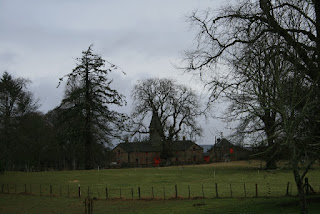OUTSIDE IN DORES
Half past ten on a Sunday morning and here we all are gathered together in a pub car park!
It was the car park at the Dores Inn and we were getting ready to go for a walk around Aldourie - we didn't actually get to go into the pub until a good bit later.
You can't stop at Dores and not take a photo up Loch Ness towards the south-west.
Nor can you avoid the ducks, which I suspect, don't go very far given the availability of food.
Just to prove we were where we said we were.
Mealfuarvonie is over 2200 feet high. The name derives from the Gaelic - Meall-fuar-mhonaidh, mountain of the cold moor.
And it certainly was more than a bit Baltic walking along the beach. In fact, Maureen looks frozen.
Once we got into the trees it got significantly less cold - not exactly warm, but not perishing cold either. Also, once we got into the woods, Hugh got the map out. As always this sends tremors of worry and disquiet among us all given his propensity for getting lost - or more euphemistically - straying from the one true path.
We were soon, however, on our way on the one true path.
It wasn't long until we came upon the first odd sighting of the day - a sunken yacht. There were some stupid questions about how this had happened and some more mysterious questions about how they might recover it. The consensus answer for the first was that it had filled up with water. For the second there were theories about filling up balloons or dragging it up the beach. Readers can take their choice or invent their own theory.
A strange-shaped roof on a little hut of indeterminate function.
It had a little skiff in it, but it didn't look like a boathouse and it was further from the water than these normally are. Another mystery of Loch Ness.
A quandary - no way to go forward. There was a path, but it was not terribly inviting.
Mainly because of this unambiguous sign.
The castle did look good, but we have been in a bit of bother for walking too close to it before. So we didn't do so again.
Aldourie Castle is the only inhabited castle on the shores of Loch Ness. It was built in 1626 with various additions being made in 1850 and a total refurbishment undertaken in 1900.
It is currently luxury accommodation and we could have hired it for the weekend for a sum that is not disclosed on their website. I take the view that if you have to ask how much, you can't afford it.
For information, in case you need to know, you can hire the Castle for a whole week for only £40000. Yes that's right - Forty thousand pounds.
So we turned right and walked into the trees. We sat on a log and Hugh and Pam produced a dinky little birthday cake for Sharon, whose birthday it was the day before the walk.
To all intents and purposes we had a birthday tea in the Castle grounds and very good it was too.
If Sharon was wishing for a week at the Castle, she was going to be sadly disappointed.
Despite not being made by either Hugh or Pam, the cake was very good as you can see.
We had a little poke around Aldourie Castle Stables, which looks ripe for conversion to some nice accommodation.
After a few more avaricious glances over the fence we turned towards the more affordable option of lunch at the Dores Inn.
As if anticipating the opening of a bottle of wine we passed the corkscrew tree.
Spring was clearly on the way and there was plenty frog spawn, bizarrely situated in ruts in the road. Not an ideal survival strategy methinks.
The route looked blocked, but actually it was a helpfully placed photo-opportunity.
Having said that, Sandra really should have stood at the lower end of the trunk.
Moss on the one side of the trees. As we intrepid walkers know, moss always grows on the north side of trees.
Actually it doesn't - or at least not always. Moss needs moisture to grow, so moss grows on the wetter side of trees. The reason it works most of the times in the northern hemisphere is that the sun dries moisture running down trees and does most of that drying when at its highest. So, this far north, the north side of the tree is sheltered from the drying effect and the moss grows best. However, other shadows from trees, rocks and landforms can all cast shadows and affect the growth of moss, so it might grow equally well on the east or west. The moral is - learn to use a map and a compass. I hate to go back to Hugh and navigational skills, so I won't.
Soon we were back in Dores and Dave found a swing to play on.
He wasn't alone
So, after the swinging sixties and seventies we arrived back at the pub where we had an excellent lunch of varying degrees of hugeness. Suffice to say that Pam had whale and chips and decided` that she didn't need to cook again until Wednesday, so Hugh would starve.
A very good walk and well done to Hugh and Pam for the organisation - including the very good lunch.




































































